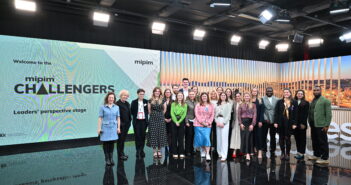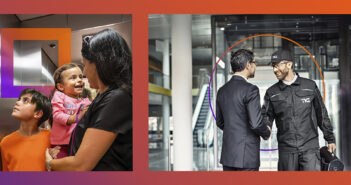The headlines touting developments in PropTech are exciting, but too often they offer more buzz than bucks, more trends than transformation. You can forgive a rolled eye or penetrating question — Does this really work? Does it pay off?
Too often, conversations about tech and commercial real estate sound more like sci-fi plot devices than practical prescriptions for adding value to commercial locations: Drones provide overhead site footage. Robots patrol night-time campuses. Artificial intelligence and machine learning algorithms pick the next most profitable spot to open a retail franchise. Brokers offer clients 3D walk-throughs — and the buildings themselves can be “smart” these days, which is more than most self-aware CRE technology professionals are willing to say about ourselves.
But taken together, the wins add up and offer actionable guidelines for developing a successful technology strategy.
Based on Cushman & Wakefield’s experience, interactions with our clients, our partnership network, and the results of our collective experimentation, we have seen emerging best practices for profitable PropTech and how to employ tech in ways that elevate the value of commercial buildings.
To be sure, clients are finding value – so far – more often from ad hoc experimentation and isolated use cases than from overall strategies.
Yet the advantages Cushman & Wakefield is seeing have grown clearer: our clients show us what problems are worth solving. Meanwhile, our venture capital sourcing partnerships show us the best tools for solving those problems. And our university and VC thought leadership partners also help us look over the horizon to see the shifts that again will change our industry.
Collectively, these insights offer a playbook for the foreseeable future.
The expectations of occupiers and employees are the key flywheel for change. Technology chases business needs and investment strategies — not the other way around. Winning strategies employ the most useful differentiating experiences, and all wins are very local. The right options often balance expense and benefits on a building-by-building basis, requiring an increasingly thoughtful approach from owners, managers, and large occupiers.
Shifts in demand drive trends toward more technology-enabled, flexible commercial sites
In the current evolving market, Cushman & Wakefield sees demand for elevated tenant experiences as a key driver of the next technology trends. Meanwhile, tightening economic conditions are likely to reward differentiation.
Cushman & Wakefield’s clients and our technology partners have identified when and how CRE technology is adding the most value. Particularly, we are seeing advantages where technology is being used to help find, attract and retain the best workers, the most loyal customers, and the most profitable tenants.
As workers blend physical and digital work, it adds to the mounting economic pressure forcing office settings to grow denser in order to optimize utilization. This leads to office practices such as hoteling, benching, smaller interior offices – and growing calls for simple, practical technologies that enable meeting room reservations and hot-desk bookings.
Office occupiers have seized the opportunity to ask landlords for smaller floor plates and shorter lease terms and hedged their bets by increasing their demand for more flexible space to use on demand. From their perspective, site selection analytics drive location strategies, and IoT has stepped in to provide real-time monitoring of office utilization, operation, and satisfaction. Meanwhile, a new set of enterprise technologies support the booking, telephony, and mobile office infrastructure needed to support a fluid workforce in flexible workplaces growing in relevance.
Tech gives Retail and Industrial CRE a roadmap to new value
Retailers have discovered how local broker knowledge and sophisticated predictive algorithms for site selection can suggest the next most profitable place to locate their offerings. (And use the powerful combination of human judgement and algorithmic suggestion to either reality-check or validate sometimes surprising suggestions!)
At the streetfront level, computer vision counts foot traffic, sorts pedestrians into demographic groups, and plays customized, interactive content to entice targeted shoppers into stores. When there isn’t a store yet, we have seen our partners use the same systems to ask neighbours point-blank what should go into a vacant storefront, offering real-time feedback that shortens vacancies by months and supports higher asking rents.
And to fill those stores – or fulfil e-commerce orders – our clients among Industrial and Supply Chain owners, operators, and investors are turning to more flexible building types that can adjust to the ebb and flow of consumer demand and the requirements of new, emerging industries. We are working with our clients and partners to tap analytics and AI to find the most efficient pockets that can push narrower and taller last-mile logistics hubs deeper into urban areas, in places where visualized data analytics tell us employee drive times, local incentives, and optimized logistics overlap to create value.
Inside those buildings (and in the cloud), our partners reveal a world where algorithms and autonomous robots help track, pack, stack, unrack, predict, pick and ship goods to consumers who never know how e-commerce brands manage same-day deliveries from fulfilment centers increasingly around the corner from their customers’ doorsteps.
That’s what C&W clients tell us they’re doing now, and what our technology partners are seeing as the most practical value drivers in similar situations. To keep pushing the value envelope, Cushman & Wakefield is helping foster a collaborative ecosystem in which each of us prepares to operate in a world that demands more from commercial experiences and environments.
One trendy topic doesn’t (and shouldn’t) fit all
So far, many of those wins have been happy accidents, but they needn’t be. Together, they show The Art of the Possible. It may fall short of an explicit roadmap, but it does help draw grid lines over the innovation white space.
The most successful clients have charted where they would like to be — as investors, occupiers, or brands — and then have asked how Commercial Real Estate enables their business strategies long before chasing trendy technologies or asking about buzzworthy new vendors.
From there, simple questions zero in on the categories of emerging technologies to consider. Does my CRE strategy depend on attracting and retaining more tenants, or a particular segment of occupants? What experiences are table stakes for that group, and which are differentiating? Should commercial real estate technology be used to drive higher revenues, improve profitability, or both? What are my most variable or uncertain inputs?
Where have others been successful, and what version of their success can I expect, given all those qualifying questions? What new paths might be worth trying ourselves?
From there, a shorter list of more targeted and testable technologies can emerge, with exciting results. Amid all the noise around PropTech, that’s an encouraging sign, and a technology-enabled future worth planning for.



